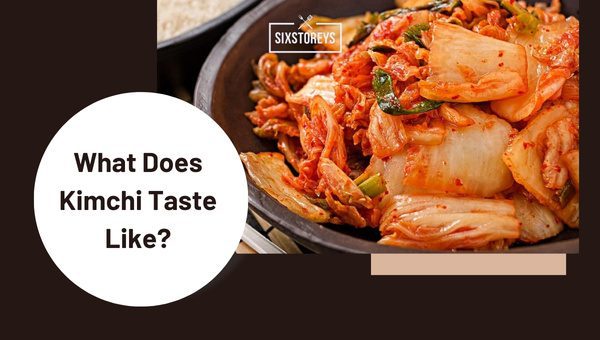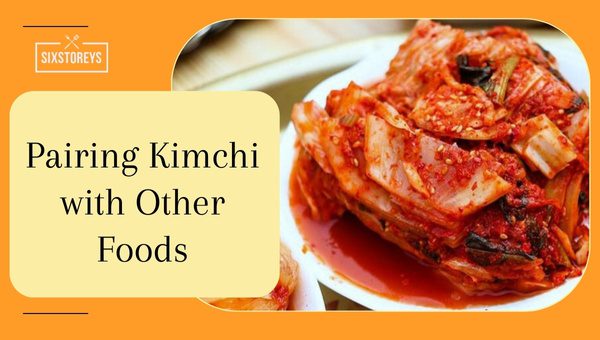What Does Kimchi Taste Like? A Journey in Every Bite
Have you ever found yourself staring at a menu in a Korean restaurant, intrigued by the colorful side dish called Kimchi but unsure about taking the plunge? Or perhaps you've heard about its health benefits and are curious, but the question lingering on your mind is, "what does kimchi taste like?" You're not alone – many have asked the same question. With its rising popularity worldwide, Kimchi is becoming an unfamiliar yet compelling item on many plates. It's not just a seminal part of Korean cuisine, but also embodies a wonderful combination of taste, texture, and health benefits. So, let's embark on a culinary journey to explore the unique flavor that is kimchi.
Also Read: What Does Cottage Cheese Taste Like?
Article Includes
What Does Kimchi Taste Like?

Kimchi's taste is complex – an unforgettable blend of tangy, spicy, and umami flavors with a crisp texture that’s undeniably addictive. It's a fascinating concoction of salty, sweet, and spicy that comes alive in your mouth. Each bite is a surprise as the flavor profile is layered and intriguing. With a base of cabbage or radish, the added ingredients such as hot pepper flakes, ginger, garlic, and fish sauce bring forth a medley of flavors.
Sour and Salty Profile
Due to the fermentation process, kimchi carries a distinct sourness. This sour tang, which is often compared with sauerkraut or pickles, is combined with a salty taste, thanks to the use of sea salt in its preparation.
Spicy Kick
The red chilli powder or Gochugaru gives kimchi its distinctive fiery kick. However, this isn't the kind of spice that assaults your taste buds; it's a slow, creeping heat that gradually warms your palate, adding to the complexity of the flavor profile.
Umami Taste and Crunchy Texture
Brimming with umami - the elusive fifth taste often associated with a sort of meaty or savory deliciousness, kimchi leaves an aftertaste that keeps you coming back for more. Besides, the crunchiness of the kimchi, especially when fresh, adds a delightful texture, enhancing the overall eating experience.
The Complex Character of Kimchi
When you first sample Kimchi, your taste buds embark on an exciting journey through a land of complex and invigorating flavors. The initial hit is a tangy sourness – a natural result of the fermentation process that embodies kimchi. You'll then notice a delightful saltiness enhanced by the use of sea salt or brine.
However, let's not forget the fiery heart of kimchi – Gochugaru or Korean chili flakes, which lends it a notable spiky heat. Combined with garlic and various seasonings that add layers of umami, Kimchi possesses a special kind of flavor ensemble that makes it an unforgettable treat.
As you chew on Kimchi, you'll also appreciate its crunchy texture. The crunch simply furthers the uniqueness of the eating experience, setting it apart from most other fermented foods out there.
Different Styles of Kimchi

If you thought Kimchi is all about spiced, fermented cabbage only, you'll be pleasantly surprised to learn that there are many different variants of Kimchi, each with its own taste. Here are a few examples:
Baechu (Cabbage) Kimchi
Undoubtedly, the most common and loved variety, Baechu Kimchi, is made from Napa cabbage. This version embodies the quintessential Kimchi flavor - sour, spicy, and crisp.
Kkakdugi (Radish Cubes) Kimchi
A distinctive type of Kimchi, Kkakdugi, is derived from cubed radishes. The radishes are diced, pickled, and fermented in a similar spice mix, but with a unique, bolder and more across-mouth feel and taste.
Oi Sobagi (Stuffed Cucumber) Kimchi
Oi Sobagi Kimchi is made of cucumbers and is often enjoyed during the summertime. The cucumber's innards are replaced with the spice mixture and left to ferment, leaving a refreshing, crisp taste that's excellent for hot weather.
The complexity of Kimchi's character is bound to surprise you, and with the various styles available, there's a flavor profile to suit just about any palette.
Why Kimchi Taste Evolves Over Time?
Kimchi holds a fascinating characteristic that sets it apart from most other foods. The taste of kimchi evolves over time. It's like a living entity, its flavor profile changing and growing more complex as it ferments.
When you first make or buy kimchi, the cabbage is still crisp, and the flavors of garlic, ginger, and chili are prominent. This stage, known as fresh or geotjeoli kimchi, is mildly sour and has a robust spiciness. However, as time passes, the chemistry of kimchi transforms.
The fermentation process begins with the bacteria naturally present on the cabbage leaves converting sugar into lactic acid. This bacteria, Lactobacillus, is also found in other fermented foods like yogurt and sauerkraut. As fermentation unfolds, kimchi develops its trademark sourness, somewhat resembling pickles. The once crisp texture gives way to a softer, more complex state. This older or mature kimchi is tangier, and the flavor deepens to deliver an explosion of umami.
Interestingly, you can control the speed of this fermentation. If you leave your kimchi at room temperature, it will ferment more rapidly. However, most people prefer to allow it to ferment slowly in the refrigerator.
Pairing Kimchi with Other Foods

Now that we’ve explored how and why kimchi’s flavor evolves, let’s talk about how you can incorporate it into your meals. Truly, the vibrant flavor of kimchi can make a humble dish extraordinary.
Kimchi's tangy, spicy elements make it an excellent companion for rich, fatty foods. Serving it alongside barbecued meats or crispy fried chicken can help cut through the richness, offering a refreshing contrast.
For a classic pairing, try it with steamed white rice. The simplicity of the rice complements the complexity of kimchi beautifully. Similarly, a bowl of piping hot ramen with a side of kimchi is a match made in culinary heaven.
Moreover, kimchi is also widely used as an ingredient in other dishes. Kimchi fried rice or Kimchi-bokkeum-bap adds a flavorful punch to a simple meal. Kimchi stew or kimchi jjigae is another popular Korean dish, boasting a rich, hearty, and soulful taste.
Kimchi isn't just for Korean cuisine either. You can use it to spice up a simple grilled cheese sandwich, top a hot dog, or even fold it into a omelette. Really, the possibilities are endless.
Remember, there are no set rules for pairing foods. It's all about finding what combination makes your palate dance!
Whether you’re savoring it fresh, enjoying it mature, or pairing it with various dishes, kimchi offers a delightful gustatory experience, making it worth the culinary exploration.
Making Your Own Kimchi at Home

Who knew your kitchen could turn into a mini Korean within a few hours? Indeed, making your own kimchi can be a delightfully easy process. Here's how.
Ingredients:
- 1 head of napa cabbage
- Salt
- Korean red chili powder (gochugaru)
- Sugar
- Fish sauce
- Minced garlic and ginger
- Sliced daikon radish
- Scallions
- Carrots
- Step 1: Cut the cabbage into quarters lengthwise and remove the core. Cut each quarter crosswise into bite-size pieces.
- Step 2: Soak the cabbage pieces in a saltwater bath for about 2 hours to soften.
- Step 3: Rinse the cabbage under cold water 3 times to ensure it's clean and salt-free, then drain.
- Step 4: Mix together the remaining ingredients to create a thick paste. This paste is the soul of your kimchi. The spiciness, the tang, the garlicky kick, everything is in there!
- Step 5: Get your hands dirty and massage the paste thoroughly into the cabbage.
- Step 6: Pack the cabbage into a jar, packing it down hard so that the brine rises. Seal the jar and it's ready for fermentation. Your homemade kimchi will be ready in a few days to weeks depending on the temperature of your kitchen.
Remember, making kimchi at home gives you the freedom to adjust the flavor profile to your own preference. So feel free to tweak the recipe as you wish.
Appreciating the Healthy Side of Kimchi
Who said tasty food can't be healthy? With kimchi, you can have your cake and eat it too. Let's delve into the health benefits a little more.
Rich in Probiotics
Ever heard of Lactobacillus? It's one of many probiotics present in kimchi due to the fermentation process. Probiotics are great for your gut health, helping with digestion, and even boosting immunity. So, start treating your gut better with some tangy, spicy kimchi!
Loaded with Vitamins and Minerals
Kimchi is a fantastic source of essential vitamins and minerals. It's rich in Vitamins A, B, and C, and minerals like potassium, calcium, and magnesium. Yes, this side dish really is a nutritional powerhouse!
May Aid Weight Management
Some research suggests that the fermentation process in kimchi can help manage weight. The probiotics produced may help you maintain or achieve your ideal weight.
The list goes on, from potentially reducing heart disease risk to maintaining skin health - kimchi does it all. No wonder it has been an integral part of Korean food culture for centuries!
However, if you're watching your sodium intake, do keep in mind that kimchi can be quite high in salt. So enjoy the spicy, tangy goodness in moderation.
As you dive into the world of kimchi, you'll find that it's not just about the taste but also the health-boosting benefits that make this dish a true star. So arm yourselves with chopsticks, and get ready to explore the spicy, tangy, umami party that's waiting on your plate. Enjoy your homemade, healthy kimchi!
Also Read: What Does Rutabaga Taste Like?
Frequently Asked Questions
Is kimchi always spicy?
While many varieties of kimchi are spicy, it doesn't always have to be. The level of spiciness can be adjusted according to personal preference when homemade or there are mild options available in stores.
Does all kimchi taste the same?
No, there are many different varieties of kimchi, which can be made with different vegetables and ingredients. This results in a multitude of flavors and textures in different types of kimchi.
Can you eat kimchi by itself?
Absolutely! Many people enjoy kimchi alone as a side dish. However, its unique flavor also makes it a great addition to various dishes.
How do you know if kimchi is bad?
Kimchi is fermented, so an 'off' smell isn't necessarily a bad sign. However, if it develops mold or an unusually strong, unpleasant smell, it's time to get rid of it.
How does the flavor of kimchi change over time?
Kimchi becomes more sour and tangy over time due to the continued fermentation process. Some people prefer fresh, less fermented kimchi while others enjoy matured, heavily fermented kimchi.
What is a typical serving size for kimchi?
A typical serving size for kimchi is around two tablespoons. Remember, it's a potent dish, so a little goes a long way!
Does cooking kimchi change its taste?
Yes, cooking kimchi can alter its flavor. It can become milder and sweeter when cooked, making it a versatile ingredient in various dishes like stir-fries and soups.
Conclusion
After reading this, you may have a clearer idea about what kimchi tastes like. Yet, its complex blend of flavors and its ability to change as it ages can only be truly understood through personal experience. The next time you come across kimchi, whether in a Korean restaurant or a local supermarket, don't hesitate to try some and embark on an exciting culinary adventure. Because, let's face it, no amount of description can replace the unique pleasure that comes from taking a bite of this fermented gem.
Discovering the taste of kimchi is indeed a rite of passage, broadening your gastronomical horizons and enriching your palette with its distinct combination of spice, tanginess, crunchiness, and umami. So here's hoping you’ll soon find yourself enjoying kimchi as a regular part of your meals, savoring its bold and vibrant taste that has won hearts and taste buds across the globe.
